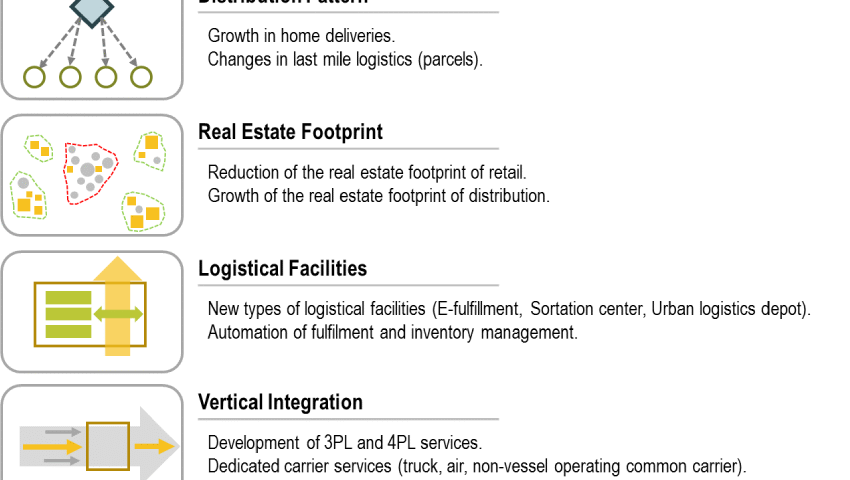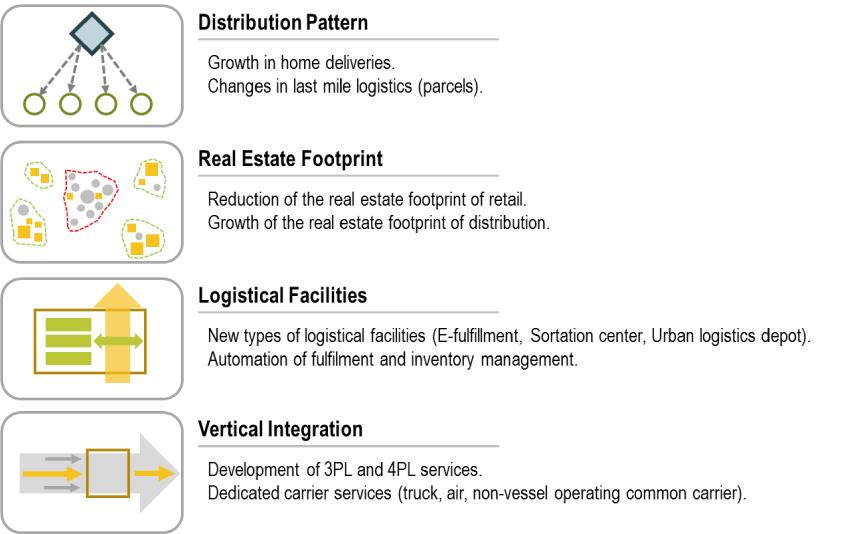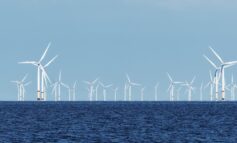Although several aspects of e-commerce are perceived as a retail activity, it can better be understood from a freight distribution perspective. Because of the characteristics of its operations, e-commerce is having four fundamental impacts on freight distribution:
• Distribution Pattern. The growth in home deliveries is one of the most tangible impacts of e-commerce as consumers are switching a growing share of their consumption (particularly discretionary) to purchases made online. Instead of a retail consumption pattern involving consumers going to stores and carry back home their purchases, with e-commerce most of these purchases are delivered through parcel services. This is changing the scale of last mile logistics with the growing role of parcel deliveries and strategies to insure that these parcels reach their consignees.
• Real Estate Footprint. The transition towards online purchases is reducing the demand for standard retail activities, implying a downward pressure on the conventional retail footprint. Many large chain retailers have been substantially reducing their footprint in recent years. Paradoxically, since home deliveries are distribution-based activities, the growth of e-commerce involves an increase of the warehousing footprint. This may also change as well real estate (and rent) values of some commercial areas since the location dynamics of distribution centers tend to favor suburban or exurban locations. Stores can also be designed to cater more effectively to the characteristics of e-commerce, acting partially as showrooms, warehouses and pickup locations.
• Logistical Facilities. E-commerce has required the development of entirely new types of distribution facilities, such as e-fulfillment centers that are designed to service large volumes of heterogeneous orders to be shipped in parcels. More than any other type of distribution centers, the high throughput requirements of logistical facilities have pressured the need for automation.
• Vertical Integration. E-commerce is reaching a throughput level giving some of its main actors significant leverage as users of logistical and transportation services. Many are developing capabilities as third party and fourth party logistics service providers, following vertical integration strategies with segments of freight distribution (home deliveries, air freight, maritime shipping). Once they reach a sufficient throughput level, online retailers may take stakes in carrier services, such as parcel deliveries by truck and even develop their own air freight services. The setting of sortation centers, urban logistics depots and freight stations (pick up points) are also part of a vertical integration strategy. The development of non-vessel operating common carrier services is an additional strategy undertaken by major online retailers relying on containerized shipping (international sourcing) and able to generate substantial container volumes.
Significant changes in contemporary logistics and freight distribution are thus being driven by e-commerce. If the automation and robotization of several manufacturing activities is considered, then even more significant changes can be expected since the means of production, distribution and consumption are concomitantly changing.
First published @The Geography of Transport Systems














